2007 CHEVROLET CORVETTE change time
[x] Cancel search: change timePage 3 of 488

GENERAL MOTORS, GM, the GM Emblem,
CHEVROLET, the CHEVROLET Emblem,
the names CORVETTE and Z06 and the
CORVETTE Emblem are registered trademarks
of General Motors Corporation.
This manual includes the latest information at the
time it was printed. We reserve the right to
make changes after that time without further
notice. For vehicles �rst sold in Canada, substitute
the name “General Motors of Canada Limited”
for Chevrolet Motor Division whenever it appears
in this manual.This manual describes features that may be
available in this model, but your vehicle may not
have all of them. For example, more than one
entertainment system may be offered or your
vehicle may have been ordered without a front
passenger or rear seats.
Keep this manual the vehicle, so it will be there if
it is needed when on the road. If the vehicle is
sold, leave this manual in it.
Canadian Owners
A French language copy of this manual can be
obtained from your dealer/retailer or from:
Helm, Incorporated
P.O. Box 07130
Detroit, MI 48207
Litho in U.S.A.
Part No. 15865975 B Second Printing
©2006 General Motors Corporation. All Rights Reserved.
3
Page 34 of 488
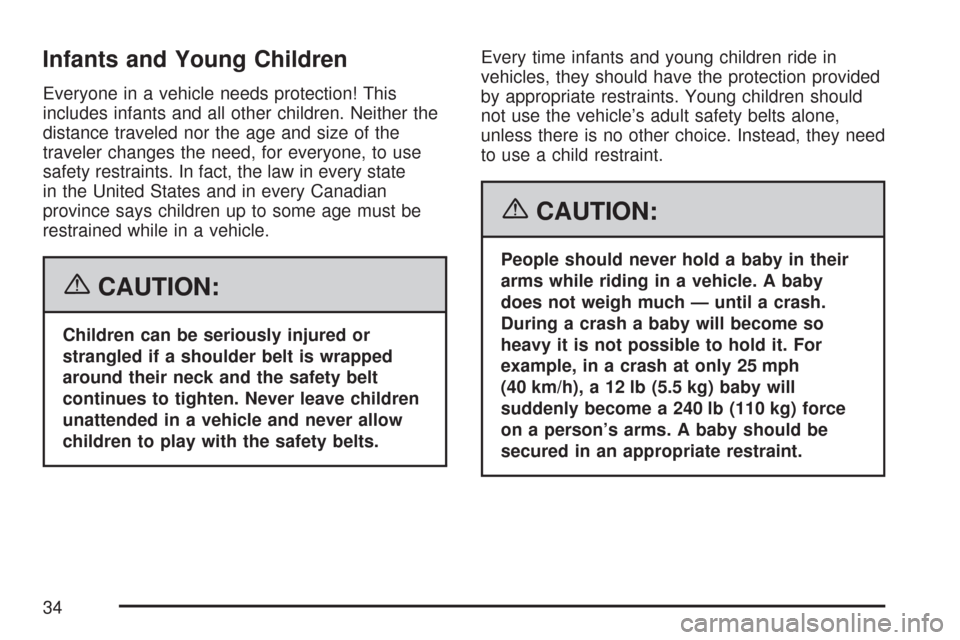
Infants and Young Children
Everyone in a vehicle needs protection! This
includes infants and all other children. Neither the
distance traveled nor the age and size of the
traveler changes the need, for everyone, to use
safety restraints. In fact, the law in every state
in the United States and in every Canadian
province says children up to some age must be
restrained while in a vehicle.
{CAUTION:
Children can be seriously injured or
strangled if a shoulder belt is wrapped
around their neck and the safety belt
continues to tighten. Never leave children
unattended in a vehicle and never allow
children to play with the safety belts.Every time infants and young children ride in
vehicles, they should have the protection provided
by appropriate restraints. Young children should
not use the vehicle’s adult safety belts alone,
unless there is no other choice. Instead, they need
to use a child restraint.
{CAUTION:
People should never hold a baby in their
arms while riding in a vehicle. A baby
does not weigh much — until a crash.
During a crash a baby will become so
heavy it is not possible to hold it. For
example, in a crash at only 25 mph
(40 km/h), a 12 lb (5.5 kg) baby will
suddenly become a 240 lb (110 kg) force
on a person’s arms. A baby should be
secured in an appropriate restraint.
34
Page 77 of 488
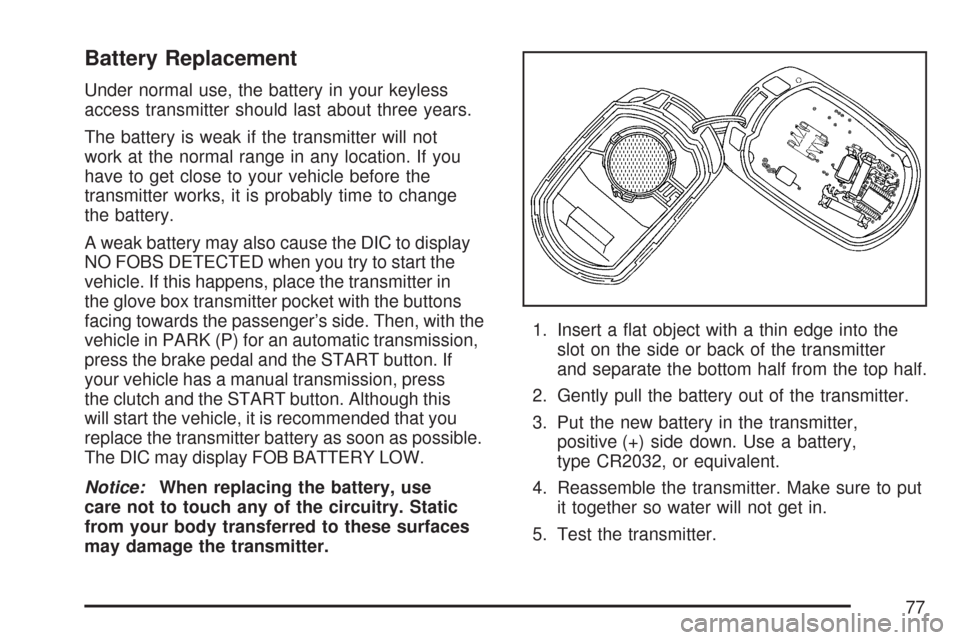
Battery Replacement
Under normal use, the battery in your keyless
access transmitter should last about three years.
The battery is weak if the transmitter will not
work at the normal range in any location. If you
have to get close to your vehicle before the
transmitter works, it is probably time to change
the battery.
A weak battery may also cause the DIC to display
NO FOBS DETECTED when you try to start the
vehicle. If this happens, place the transmitter in
the glove box transmitter pocket with the buttons
facing towards the passenger’s side. Then, with the
vehicle in PARK (P) for an automatic transmission,
press the brake pedal and the START button. If
your vehicle has a manual transmission, press
the clutch and the START button. Although this
will start the vehicle, it is recommended that you
replace the transmitter battery as soon as possible.
The DIC may display FOB BATTERY LOW.
Notice:When replacing the battery, use
care not to touch any of the circuitry. Static
from your body transferred to these surfaces
may damage the transmitter.1. Insert a �at object with a thin edge into the
slot on the side or back of the transmitter
and separate the bottom half from the top half.
2. Gently pull the battery out of the transmitter.
3. Put the new battery in the transmitter,
positive (+) side down. Use a battery,
type CR2032, or equivalent.
4. Reassemble the transmitter. Make sure to put
it together so water will not get in.
5. Test the transmitter.
77
Page 108 of 488
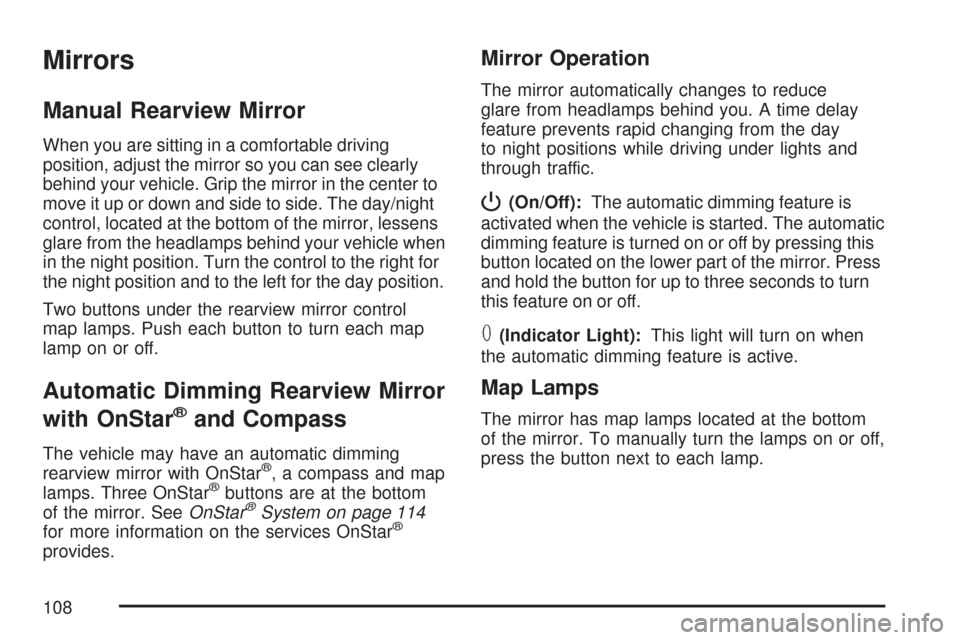
Mirrors
Manual Rearview Mirror
When you are sitting in a comfortable driving
position, adjust the mirror so you can see clearly
behind your vehicle. Grip the mirror in the center to
move it up or down and side to side. The day/night
control, located at the bottom of the mirror, lessens
glare from the headlamps behind your vehicle when
in the night position. Turn the control to the right for
the night position and to the left for the day position.
Two buttons under the rearview mirror control
map lamps. Push each button to turn each map
lamp on or off.
Automatic Dimming Rearview Mirror
with OnStar
®and Compass
The vehicle may have an automatic dimming
rearview mirror with OnStar®, a compass and map
lamps. Three OnStar®buttons are at the bottom
of the mirror. SeeOnStar®System on page 114
for more information on the services OnStar®
provides.
Mirror Operation
The mirror automatically changes to reduce
glare from headlamps behind you. A time delay
feature prevents rapid changing from the day
to night positions while driving under lights and
through traffic.
P(On/Off):The automatic dimming feature is
activated when the vehicle is started. The automatic
dimming feature is turned on or off by pressing this
button located on the lower part of the mirror. Press
and hold the button for up to three seconds to turn
this feature on or off.
T(Indicator Light):This light will turn on when
the automatic dimming feature is active.
Map Lamps
The mirror has map lamps located at the bottom
of the mirror. To manually turn the lamps on or off,
press the button next to each lamp.
108
Page 111 of 488
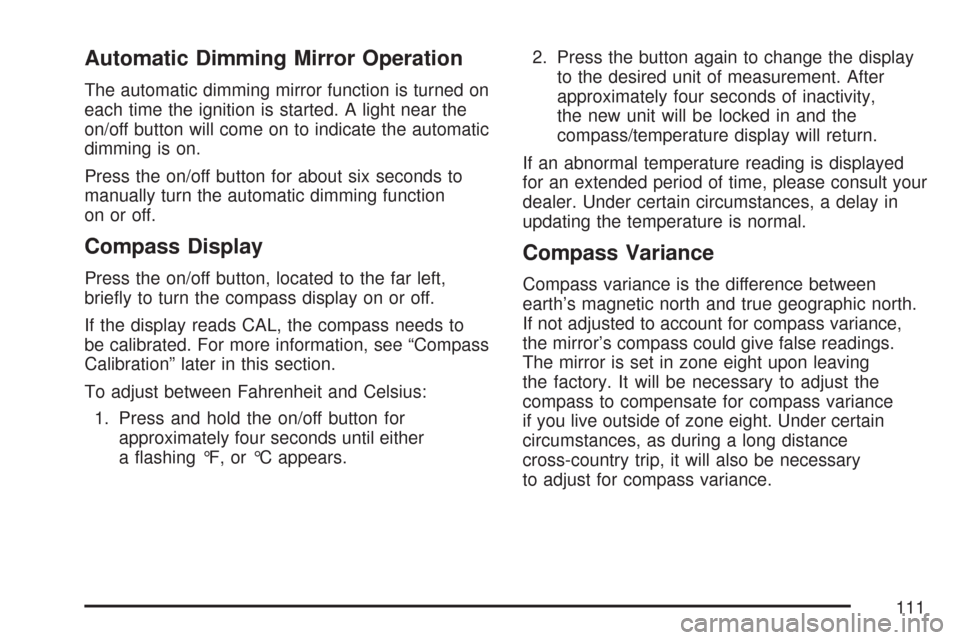
Automatic Dimming Mirror Operation
The automatic dimming mirror function is turned on
each time the ignition is started. A light near the
on/off button will come on to indicate the automatic
dimming is on.
Press the on/off button for about six seconds to
manually turn the automatic dimming function
on or off.
Compass Display
Press the on/off button, located to the far left,
brie�y to turn the compass display on or off.
If the display reads CAL, the compass needs to
be calibrated. For more information, see “Compass
Calibration” later in this section.
To adjust between Fahrenheit and Celsius:
1. Press and hold the on/off button for
approximately four seconds until either
a �ashing °F, or °C appears.2. Press the button again to change the display
to the desired unit of measurement. After
approximately four seconds of inactivity,
the new unit will be locked in and the
compass/temperature display will return.
If an abnormal temperature reading is displayed
for an extended period of time, please consult your
dealer. Under certain circumstances, a delay in
updating the temperature is normal.
Compass Variance
Compass variance is the difference between
earth’s magnetic north and true geographic north.
If not adjusted to account for compass variance,
the mirror’s compass could give false readings.
The mirror is set in zone eight upon leaving
the factory. It will be necessary to adjust the
compass to compensate for compass variance
if you live outside of zone eight. Under certain
circumstances, as during a long distance
cross-country trip, it will also be necessary
to adjust for compass variance.
111
Page 153 of 488

Instrument Panel Overview........................ 156
Hazard Warning Flashers.......................... 158
Other Warning Devices............................. 159
Horn.......................................................... 159
Tilt Wheel.................................................. 159
Turn Signal/Multifunction Lever.................. 160
Turn and Lane-Change Signals
(Auto Signal).......................................... 161
Headlamp High/Low-Beam Changer.......... 162
Flash-to-Pass............................................ 162
Windshield Wipers..................................... 162
Windshield Washer.................................... 163
Cruise Control........................................... 164
Exterior Lamps.......................................... 168
Wiper Activated Headlamps....................... 169
Headlamps on Reminder........................... 169
Daytime Running Lamps (DRL)................. 169
Fog Lamps................................................ 171
Twilight Sentinel
®...................................... 171
Exterior Lighting Battery Saver.................. 172
Instrument Panel Brightness...................... 172
Courtesy Lamps........................................ 173
Entry/Exit Lighting...................................... 173
Reading Lamps......................................... 173
Battery Run-Down Protection..................... 173Head-Up Display (HUD)............................ 174
Accessory Power Outlet(s)........................ 178
Ashtray(s) and Cigarette Lighter................ 179
Climate Controls......................................... 179
Dual Automatic Climate Control System.... 179
Outlet Adjustment...................................... 186
Passenger Compartment Air Filter............. 186
Warning Lights, Gages, and Indicators..... 188
Instrument Panel Cluster........................... 189
Speedometer and Odometer...................... 190
Tachometer............................................... 190
Safety Belt Reminder Light........................ 190
Airbag Readiness Light............................. 191
Passenger Airbag Status Indicator............. 192
Voltmeter Gage......................................... 194
One-to-Four Shift Light
(Manual Transmission)........................... 195
Brake System Warning Light..................... 196
Anti-Lock Brake System Warning Light...... 197
Traction Control System (TCS)
Warning Light........................................ 197
Active Handling System Light.................... 198
Engine Coolant Temperature Gage............ 199
Section 3 Instrument Panel
153
Page 161 of 488

ICruise Control. SeeCruise Control
on page 164.
PExterior Lamps Control. SeeExterior
Lamps on page 168.
Turn and Lane-Change Signals
(Auto Signal)
The turn signal has two upward (for right) and
two downward (for left) positions. These positions
allow you to signal a turn or a lane change.
To signal a turn, move the multifunction lever all
the way up or down. When the turn is �nished,
the lever will return automatically.
An arrow on the
instrument panel
cluster will �ash in
the direction of the
turn or lane change.To signal a lane change, just raise or lower the
lever until the arrow starts to �ash. Release
the lever and the turn signal will automatically �ash
three times. If more �ashes are desired, continue
to hold the lever.
If you signal a turn or a lane change and the
arrows �ash faster than normal, a signal bulb may
be burned out.
If a bulb is burned out, replace it to help avoid an
accident. If the arrows do not go on at all when
you signal a turn, check the fuses and check
for burned-out bulbs. SeeFuses and Circuit
Breakers on page 419.
Turn Signal on Chime
A chime will remind you if you leave the turn
signal on for more than three-quarters of a mile
(1.2 km) of driving.
If you need to leave the turn signal on for more
than three-quarters of a mile (1.2 km), turn off the
signal and then turn it back on.
161
Page 170 of 488
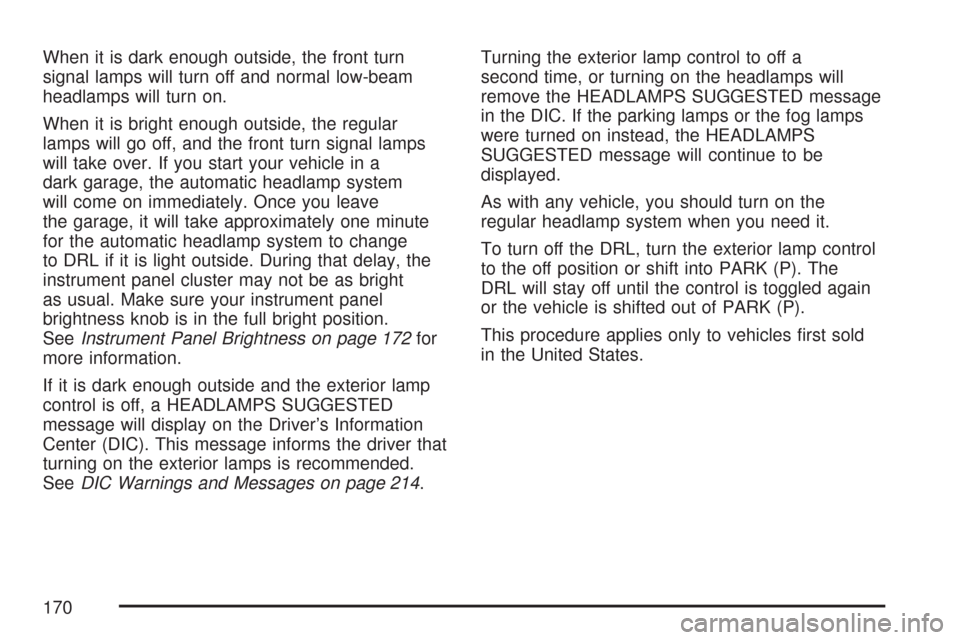
When it is dark enough outside, the front turn
signal lamps will turn off and normal low-beam
headlamps will turn on.
When it is bright enough outside, the regular
lamps will go off, and the front turn signal lamps
will take over. If you start your vehicle in a
dark garage, the automatic headlamp system
will come on immediately. Once you leave
the garage, it will take approximately one minute
for the automatic headlamp system to change
to DRL if it is light outside. During that delay, the
instrument panel cluster may not be as bright
as usual. Make sure your instrument panel
brightness knob is in the full bright position.
SeeInstrument Panel Brightness on page 172for
more information.
If it is dark enough outside and the exterior lamp
control is off, a HEADLAMPS SUGGESTED
message will display on the Driver’s Information
Center (DIC). This message informs the driver that
turning on the exterior lamps is recommended.
SeeDIC Warnings and Messages on page 214.Turning the exterior lamp control to off a
second time, or turning on the headlamps will
remove the HEADLAMPS SUGGESTED message
in the DIC. If the parking lamps or the fog lamps
were turned on instead, the HEADLAMPS
SUGGESTED message will continue to be
displayed.
As with any vehicle, you should turn on the
regular headlamp system when you need it.
To turn off the DRL, turn the exterior lamp control
to the off position or shift into PARK (P). The
DRL will stay off until the control is toggled again
or the vehicle is shifted out of PARK (P).
This procedure applies only to vehicles �rst sold
in the United States.
170